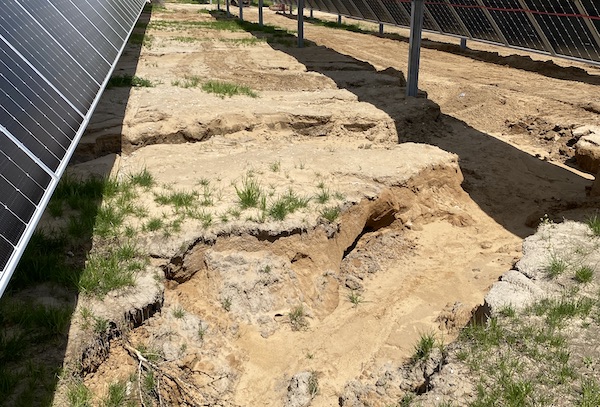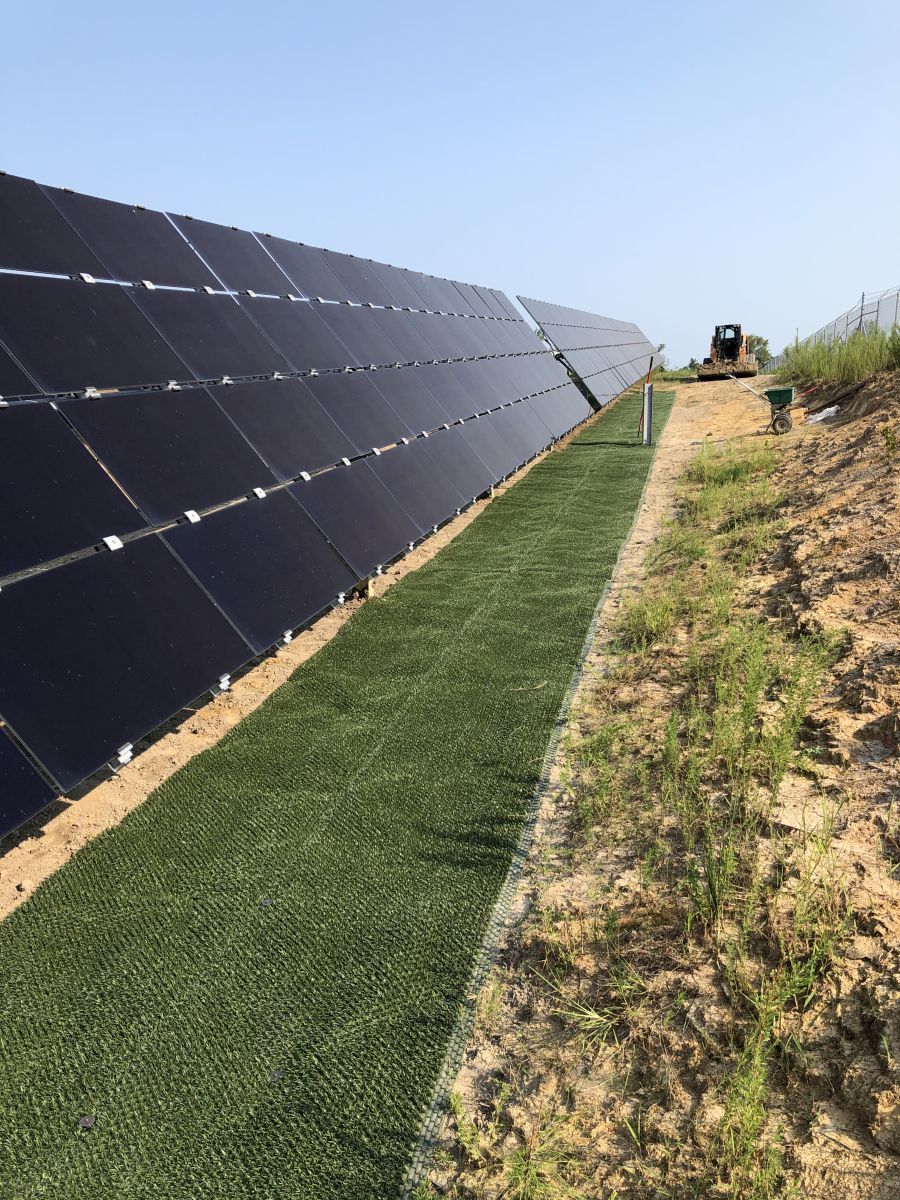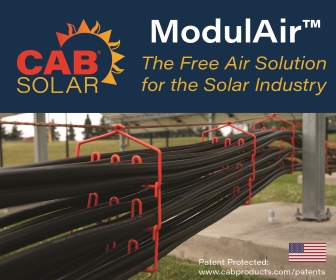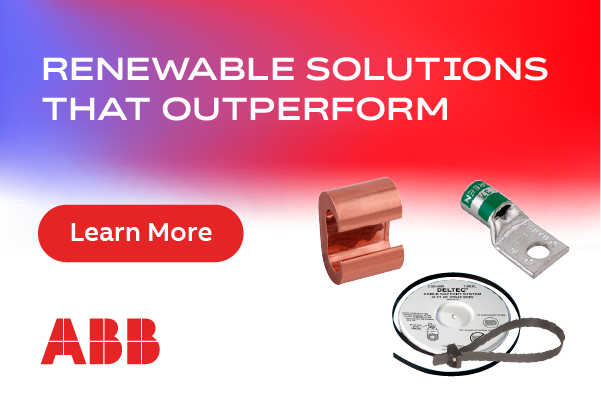Solar Farm Erosion Protection is Not One-Size-Fits-All
Soil erosion poses significant challenges and risks throughout the life cycle of a solar farm, from construction to operation. Understanding the effects of erosion on solar projects is crucial for solar developments to start off on the right foot and stay functional throughout their lifespan. In this article, we will outline the implications of erosion on solar farms, and explore potential solutions to address these concerns.
The importance of erosion control
The frequency of high intensity storms has been increasing, emphasizing the need for effective erosion control measures in medium- to large-scale solar farm developments. Climate change is likely to lead to increased annual rainfall, and subsequent erosion and runoff. Even areas with decreased rainfall may become more susceptible to erosion due to decreased biomass production. In short, the climate in many parts of the world is trending towards increased erosion, so it’s important to outfit your solar development accordingly.

In addition to environmental concerns, erosion also has financial and reputational implications for solar facilities. Local governments and the public are increasingly scrutinizing solar site aesthetics and environmental practices. Instances of damage caused by improper erosion control measures have resulted in lawsuits and settlements, highlighting the need for proper planning and implementation. Proactive erosion control can help prevent unnecessary repairs and maintenance, reduce environmental damage and subsequent fines, and beautify your project in the critical eyes of the public.
Erosion hotspots in the solar farm industry
- Panel Drip Lines
One of the most common forms of erosion on a solar farm occurs along the “drip line” that forms where rainfall falls down the sloped side of the panels. This drip line poses a problem because it increases erosion very close to the panels. Drip line erosion can quickly make its way to the panel uprights, eventually compromising them, leading to unnecessary maintenance or repairs on their arrays. The unfortunate reality is, the more unnecessary activity that occurs near the arrays such as maintenance, the greater chance of accidental damage and subsequent repairs.
- Drainage Channels
Drainage channels are necessary to divert and redirect water so it doesn’t collect in crucial locations. A flooded array is a nightmare for solar farms. The challenge all too often is that these channels erode and sediment washes off the property. Properly outfitted drainage channels lose very little soil as water flows through them, safely redirecting and removing water without causing damage to your land. An improperly outfitted drainage channel is also at risk of spreading pollutants and violating SWPPP regulations, leading to heavy fines and poor public image.
- Slopes
Slopes are becoming more common on solar developments due to the rapid proliferation of solar farms. Slopes are a common hotspot for erosion; as water flows down the slope, it collects sediment, soil, and pollutants. Without proper erosion control, rills begin to form on the slope, creating more paths for water to flow and exposing more surface area to erosion. Arrays mounted on sloping areas are at risk of erosion around pilings as well as accelerated dripline erosion.
- Retention Ponds
Though we may only see small ripples on the surface of retention ponds, such forces can work surprisingly quickly to erode and destabilize shorelines. Erosion on pond banks can cause ponds to rapidly fill with sediment and lose their holding capacity. Furthermore, undercut, destabilized banks are unsafe for workers, especially if they are operating a vehicle or heavy equipment nearby. A protected retention pond shoreline will prevent expensive bank restoration later down the line, and will ensure that the land surrounding the pond remains useful and safe.
 Selecting the right erosion control solution
Selecting the right erosion control solution
Erosion control products make up a spectrum from heavier hard armor materials to lighter soft armor materials. Here we will go over just two ends of the spectrum.
Hard armor solutions
Hard armor solutions, such as rock riprap, provide immediate and generally reliable erosion protection in particularly erosion-prone contexts. For example, hard armor is the standard for shoreline applications where heavy wave action is expected.
Rock can be cheap, but that is highly dependent on the site’s proximity to the quarry and the whims of quarry owners. It’s not uncommon for transportation to be exorbitantly expensive for these heavy materials. Rock's weight and the uneven footing it provides can also make maintenance difficult and potentially hazardous. Mowing equipment and vehicles can easily throw rocks and damage the panels.
Soft armor solutions
Permanent Rolled erosion control products (RECPs) such as Turf Reinforcement Mats (TRMs), offer less equipment-intensive installation and maintenance compared to hard armor solutions. They are generally more cost-effective and easier to transport than rock, and are more people-friendly to walk on. Soft armor products are usually designed to work in tandem with vegetation to protect soil and filter pollutants. That means a greener, more natural look for your solar development, so locals will be more supportive of your endeavors.
However, most TRMs offer very limited erosion protection when first installed. They also require a 6-12+ month vegetation grow-in period before reaching their maximum erosion resistance. For erosion-prone areas subject to significant water flow prior to vegetation establishment, a new type of permanent RECP, known as Instant Armor Mats, may be necessary. Instant Armor Mats utilize simulated turf to provide immediate erosion protection similar to rock riprap and prevent washouts during heavy storms occurring soon after installation.
Finding the right balance
The range of erosion control measures is greater than the scope of this article. It may be prudent to utilize soft armor solutions near your arrays — like along the drip lines — and hard armor solutions elsewhere. Every piece of land is unique. When properly protected, a solar development will reliably generate clean energy throughout its lifespan and have a better chance of standing up to Mother Nature.
Tim Lancaster is Vice President Sales of InstaTurf, a division of GrassWorx, which offers effective soft armor alternatives to rock riprap and other hard armor systems for permanent erosion protection.
InstaTurf | insta-turf.com
Author: Tim Lancaster
Volume: 2023 September/October









.png?r=5682)



